Amazon DynamoDB
This is not an exhaustive documentation of all the existing AWS Services. These are summarized notes that I used for the AWS Certifications.
To see the complete documentation, please go to: AWS documentation
Overview
Amazon DynamoDB is a fully managed NoSQL database service that provides fast and predictable performance with seamless scalability.
- Highly available with replication across 3 AZs.
- NoSQL database - not a relational database.
- Scales to massive workloads, distributed database.
- Fast and consistent regarding performance .
- Low latency retrieval of data.
- Integrated with IAM for security, authorization and administration.
- It enables event driven programming with DynamoDB Streams.
- It provides auto scaling capabilities at low cost.
How DynamoDB works
- DynamoDB is made of tables.
- Each table has a primary key (must be decided at creation time).
- Each table can have an infinite number of items (rows).
- Each item has attributes which can be added over time (can be null).
- Maximum size of an item is 400KB.
Supported data types
- Scalar types:
- string
- number
- binary
- null
- Document types:
- list
- map
- Set types:
- string set
- number set
- binary set
Provisioned Throughput
- Table must have a provisioned read and write capacity units.
- Read Capacity Unit (RCU): throughput for reads ($0.00013 per RCU).
- 1 RCU = 1 strongly consistent read of 4 KB per second
- 1 RCU = 2 eventually consistent read of 4 KB per second
- Write Capacity Unit (WCU): throughput for writes ($0.00065 per WCU).
- 1 WCU = 1 write of 1 KB per second
- Option to setup auto-scaling of throughput to meet demand.
- Throughput can be exceeded temporarily using burst credits.
- If there are no more burst credits, we may get a "ProvisionedThroughputExceptions" in which case it is advised to do exponential back-off retry.
DynamoDB DAX (DynamoDB Accelerator)
-
Seamless cache for DynamoDB, no application re-write.
-
Write go through DAX to DynamoDB.
-
Micro second latency for cached reads and queries.
-
Solves the Hot Key problem (too many reads on one value).
-
Each cache entry has a 5 minute TTL by default.
-
We can get up 10 nodes per cluster for cache.
-
Multi AZ (3 nodes minimum recommended for production).
-
It is secure (Encryption at rest with KMC, VPC, IAM, CloudTrail).
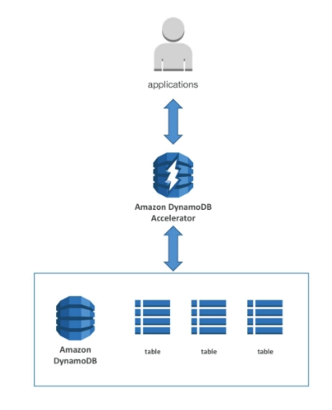
DynamoDB Streams
- Changes (Create, Update, Delete) can end up in a DynamoDB stream.
- This stream can be read by AWS Lambda, we can do some integrations:
- React to changes in real time (example: welcome email to new users)
- Analytics
- Create derivative tables/views
- Insert into ElasticSearch
- We can implement cross region replication using Stream.
- Streams has 24 hours of data retention.
Concurrency
-
DynamoDB has a feature called "Conditional Update/Delete".
-
This means you can ensure an item has not changed before altering it.
-
This makes DynamoDB optimistic locking/concurrency database.
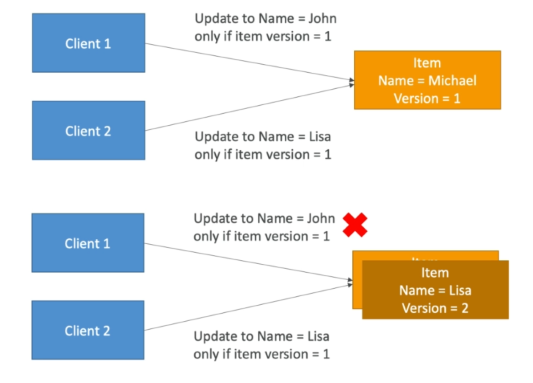
Throttling
-
If we exceed our RCU/WCU, we get "ProvisionedThroughputException"
-
Reasons:
- Hot keys - one partition key is being read too many times.
- Very large items - RCU and WCU depend on size of items.
- Hot partitions.
-
Solutions:
- Exponential backoff when exception is encountered (already in SDK).
- Distribute partition keys as much as possible.
- If RCU issue, use DynamoDB DAX.
Basic APIs
-
DeleteItem
- Delete an invidual row.
- Can perform conditional delete.
-
DeleteTable
- Delete whole table and all its items.
- Much quicker deletion than calling DeleteItem on all items.
-
BatchWriteItem
- Operations are done in parallel for better efficiency.
- It's possible for part of batch to fail.
- Up to 25 PutItem and/or DeleteItem in one call.
- Up to 16 MB of data written.
- Up to 400 KB of data per item.
-
GetItem
- Read based on primary key.
- Primary key = HASH or HASH-RANGE.
- Eventually consistent by default.
- Can use strongly consistent read, but will use more RCU, also takes longer.
-
BatchGetItem
- Up to 100 items.
- Up to 16 MB of data.
- Items are retrieved in parallel to minimize latency.
-
Query
- Returns item based on:
- partition key value
- sort key value
- Up to 1 MB of data.
- Able to do pagination.
- Can query table, a local secondary index, or a global secondary index.
- Returns item based on:
-
Scan
- Scans the entire table and then filter out data - inefficient.
- Returns up to 1 MB of data.
- Use pagination to keep on reading.
- Consumes a lot of RCU.
- For faster performance, use parallel scans.
Consistency Model
Eventually Consistent Read
- If we read just after a write, it's possible we'll get unexpected response because of replication.
- Used by DynamoDb by default but the following API provide a ConsistentRead parameter which you can set to True
- GetItem
- Query
- Scan
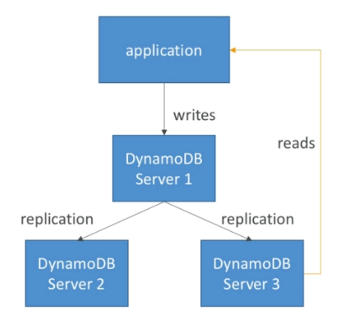
Primary Keys
-
Option 1: Partition key only (HASH)
-
Partition key must be unique for each iterm.
-
Partition key must be diverse so that data is distributed.
-
Example: user_id for a users table.
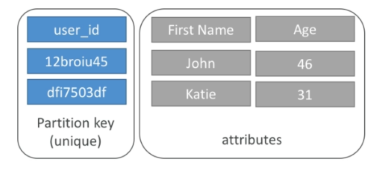
-
-
Option 2: Partition key + Sort key
-
Combination must be unique.
-
Data is grouped by partition key.
-
Sort key = range key
-
Example: users-game table
- user_id for partition key
- game_id for sort key
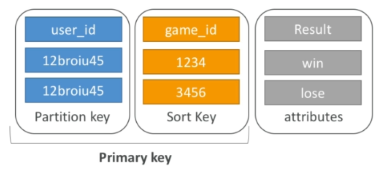
-
New Features
-
Transactions
- All or nothing type of operations.
- We can coordinate insert, update and delete operations across multiple tables.
- Include up to 10 unique items or up to 4MB of data per transaction.
-
On-demand
- No capacity planning needed (WCU/RCU) - scales automatically.
- It is 2.5x more expensive than provisioned capacity.
- Helpful for spikes and unpredictable loads or if the application has a very low throughput.
Other Features
-
Security
- We get VPC endpoints to access DynamoDB without internet.
- IAM policies
- Encryption at rest using AWS KMS.
- Encryption at transit is handled by SSL/TLS.
-
Backup and restore
- DynamoDB provides point in time restores (just like any RDS).
- Backup does not have any performance impact on the tables.
-
Global tables
- Multi region, fully replicated, high performance.
-
Replication
- Dynamo provides active-active replication.
- To replicate data, DynamoDB Streams should be enabled.
- Useful for low latency, DR purposes.
-
Migration
-
DMS can be used to migrate data to DynamoDB (from Mongo, Oracle, MySQL, st3, etc.).
-